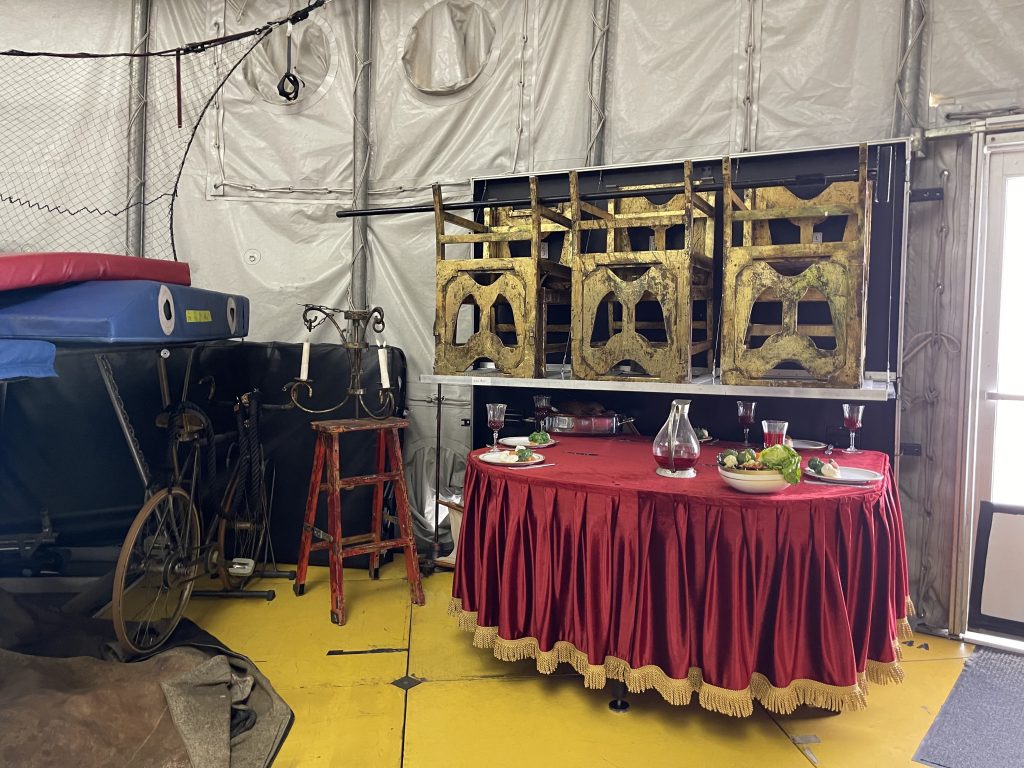
(Sophia Ling/Emory Wheel)
Red caravans. Rickety trailers. Poor, bordering homeless people looking to earn a little more cash. Caged up lions. That really disgusting carnival font.
Perhaps these are the stereotypes that come to mind when you think of circuses. Maybe you even think about “The Greatest Showman,” P.T. Barnum and the unspoken truth of human and animal exploitation capitalizing on uniqueness and body differences to turn a profit. Historically, circuses centered around entertainment from the unknown, a new business enterprise rather than an expression of art.
Not anymore. Today, the circus is an art form. Companies like Cirque du Soleil are more than the red-nosed, blundering jokesters (no offense Cameron Tucker): they are evidence of the transformation and reinvention of circus arts.
“Before, [the] circus was very traditional with animals and everything, and in the 80s in France, it started to be more about theatre and the story,” said Anne Weissbecker, an aerial bicyclist and a main character on the show who started performing with “Kurios” since its creation in 2015.
Contemporary circus arts rival their historical roots as a retelling of stories and reactions to social injustice and political commentary. In fact, for me, contemporary circuses can be the epitome of performance, athleticism and artistry.
Attending the premiere of Cirque du Soleil’s “Kurios” left me starstruck, and of course, curious. I was lucky to have the opportunity to see the wardrobe room, training gym and the props backstage.
Growing up in France, circus schools were especially popular for kids as a substitute for gymnastics or ballet. “Everybody can find something for themselves,” Weissbecker said. It’s a discipline no different from dads’ clubs in the U.S. or club athletics outside of regular school; circus training can range from aerials to juggling to balancing and walking on tightropes.
Weissbecker’s act suspends a bicycle in the air while she performs tricks on it.
“The [aerial] bicycle act is about playfulness and making people happy, so it’s a funny act actually. It’s about giving joy,” she said. “It’s a lot about looking at the audience and interacting with them, and making them feel just as happy as I am flying on the bicycle.”
Her act was created just for this show. Much of the audience, however, can’t see the small, choreographed moments in the performance. Similar to a dance number, anything out of place can result in harm or injury. “You have to make sure the pedal is in the right place,” she said.
Circuses are branching out from their not-so-illustrious past and into more experimentation, testing the limits of the human body and artistic vision. The storyline of “Kurios” itself pays homage to the steampunk Industrial Revolution, human imagination and the final message that “anything is possible.”
The possibilities are truly endless. In school, Weissbecker found a passion for the air and later attended the École Nationale de Cirque in Montreal, Canada. Schools like these, and Shana Kennedy’s Philadelphia School of Circus Arts represent the ubiquity of circus training beyond the stereotypical red and white tent. For many, circus arts blur status and class lines within society and function as an exploration into adaptation and invention. Like other forms of art – contemporary, pointillism and realism – circus art cannot just be defined with broad brush strokes. It’s time to escape the misconception of the circus as a monolith.
Interpretations and discussion of the circus from the past tend to neglect a major part of being a successful circus performer: the training. Like any other skill, training is absolutely vital, yet somehow is often left out of our conversation on the circus. Performers aren’t created overnight. People with the special talents in the circus don’t show up one day and automatically figure out how to engage with the audience or make them laugh and cry.
“I know we make it look easy,” Weissbecker said. “But all of us started when we were something like 6-10 years old, and it’s training for almost each day of your life.”
Cirque du Soleil performs around 300 shows a year, and eight to 10 shows a week can be exceptionally draining on the artists.
“If you do whatever kind of job you do, some days you’re tired and some days you’re a little bit sick or some things happen, so it’s to find the way to always be at your best,” Weissbecker added.
Ever since she became a performer, she hasn’t looked back or wanted to quit.
“I think right now I would want to stay in this universe of performing arts,” she said, “It’s a big life choice…but I love it.”
Having been around as a premier form of entertainment for hundreds of years, circus has undergone many reiterations. Perhaps that is the most striking part of the circus industry: its ability to adapt, to learn and to evolve. As humans, resisting change is natural. The fear of failure haunts our lives. But if understanding the behind-the-scenes of the circus has taught me anything, it’s that the circus is more than just a group of talented people who have some tricks up their sleeves.
Sophia Ling (24C) is from Carmel, Indiana.
Sophia Ling (she/her) (24C) is from Carmel, Indiana and double majoring in Political Science and Sociology. She wrote for the Current in Carmel. She also loves playing guitar and piano, cooking and swimming. In her free time, she learns new card tricks and practices typing faster.



